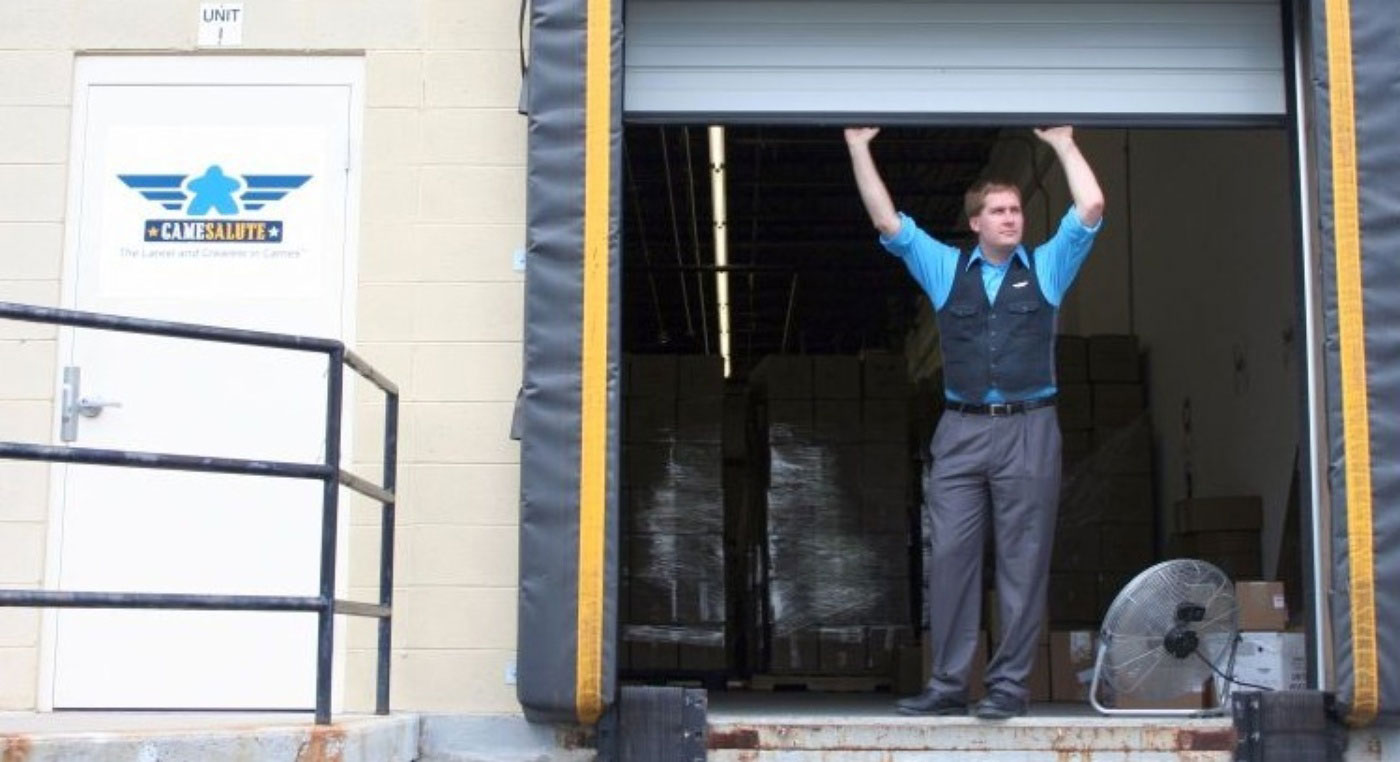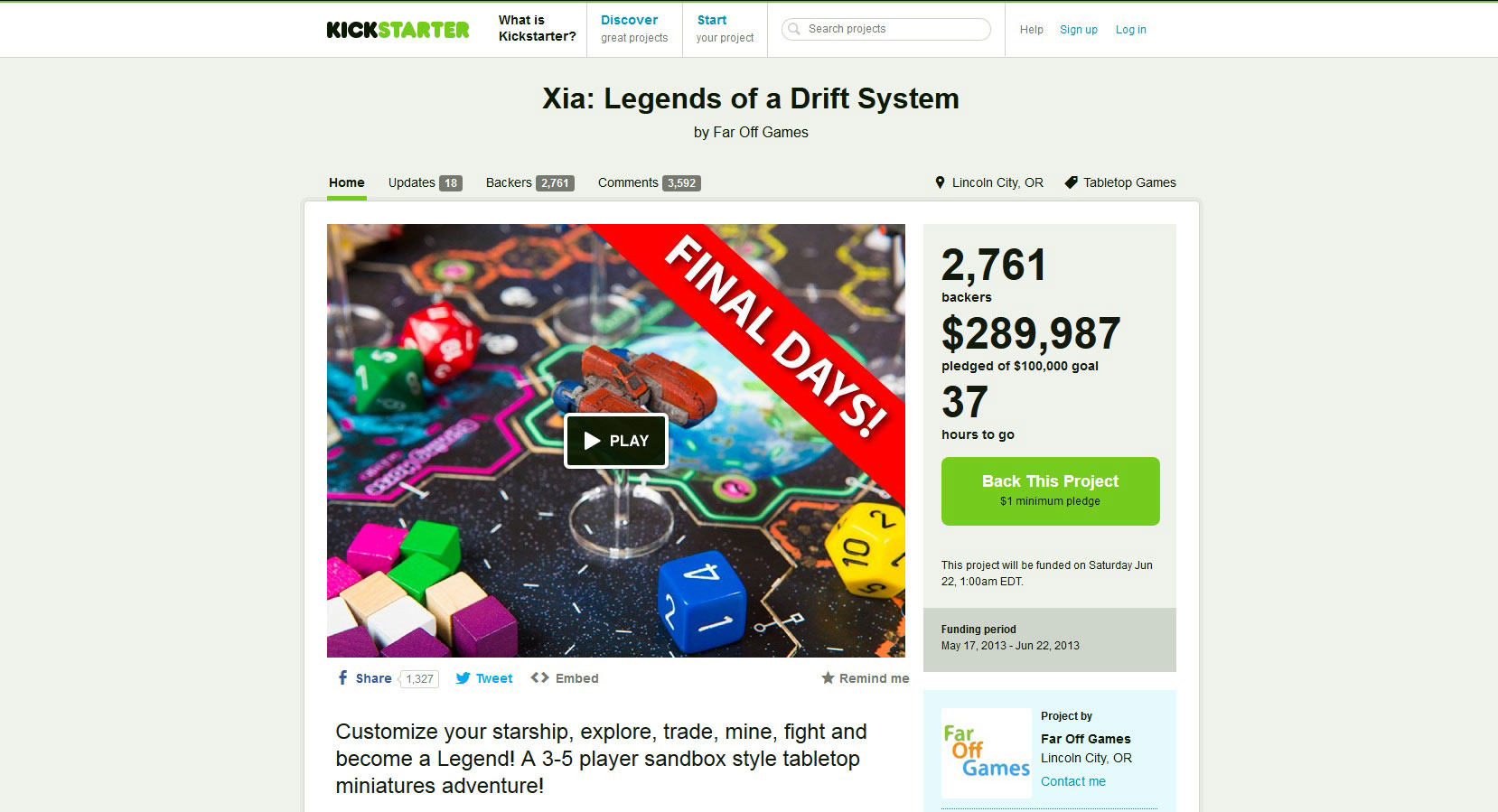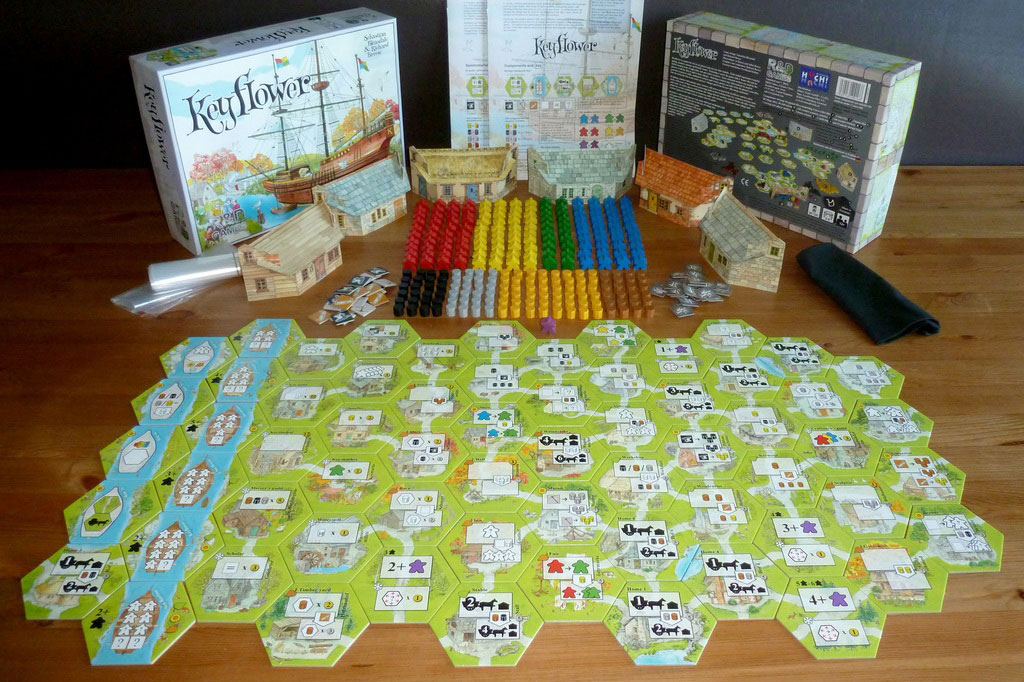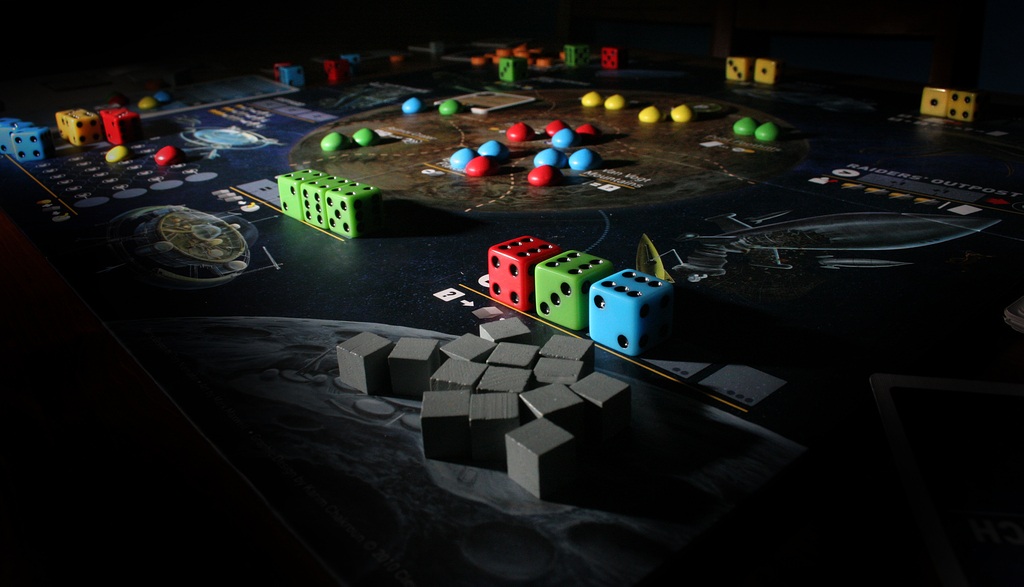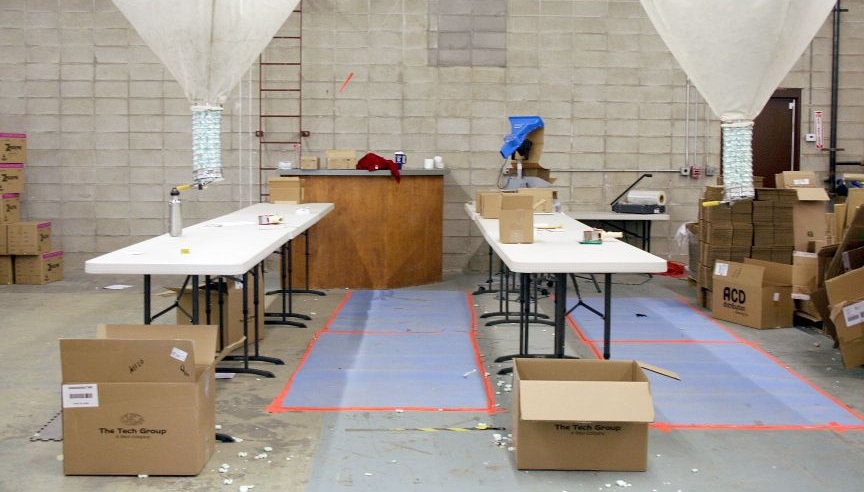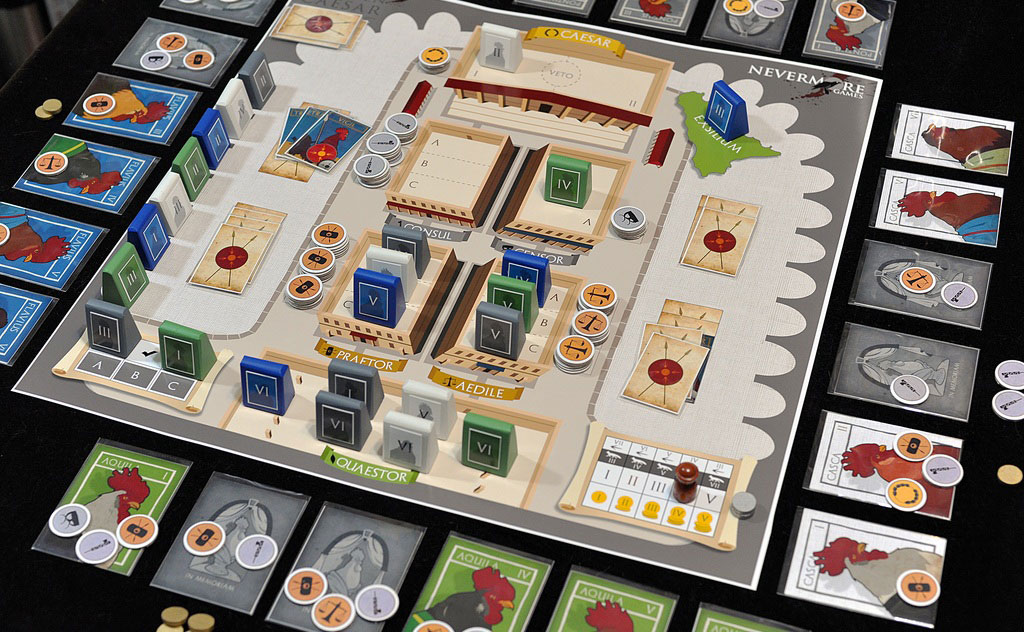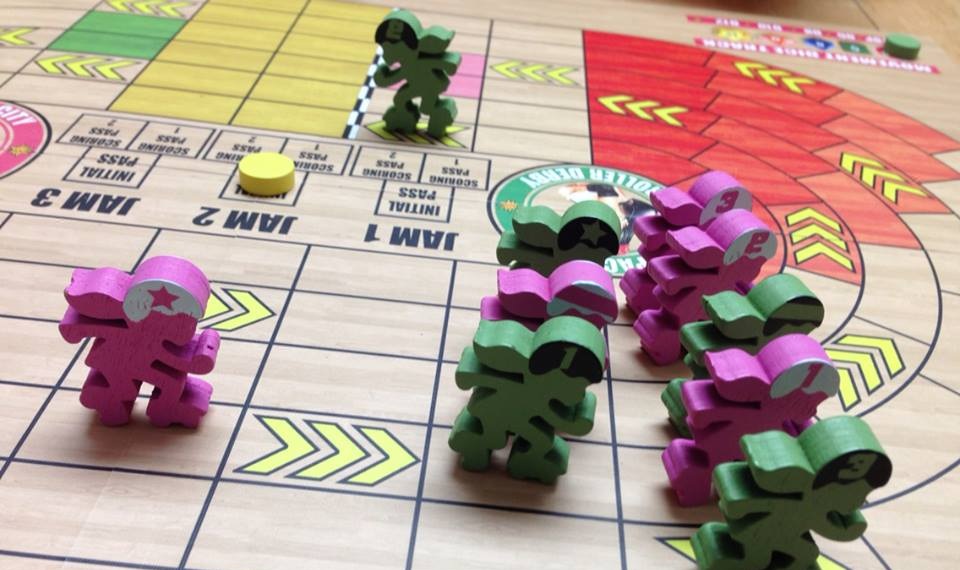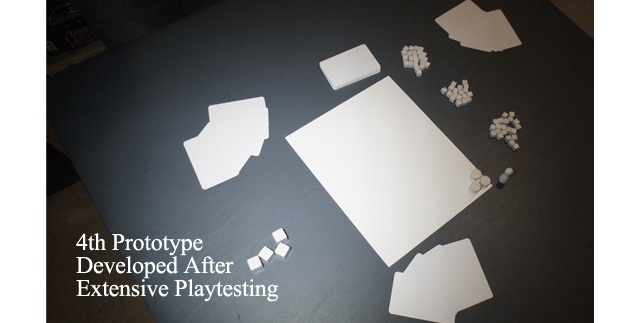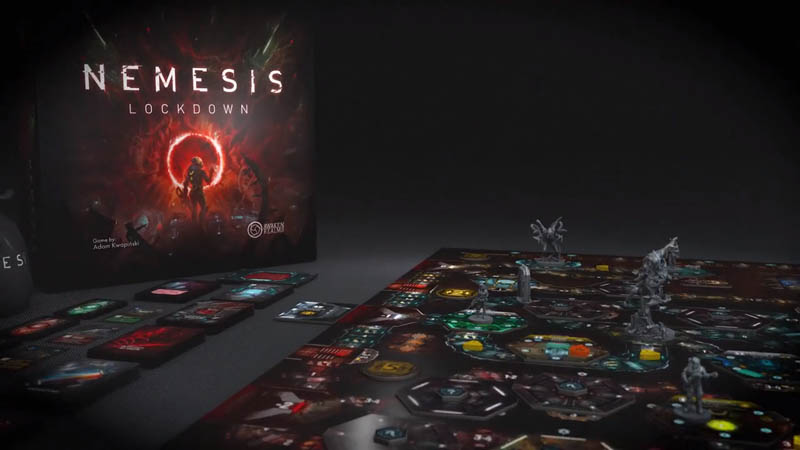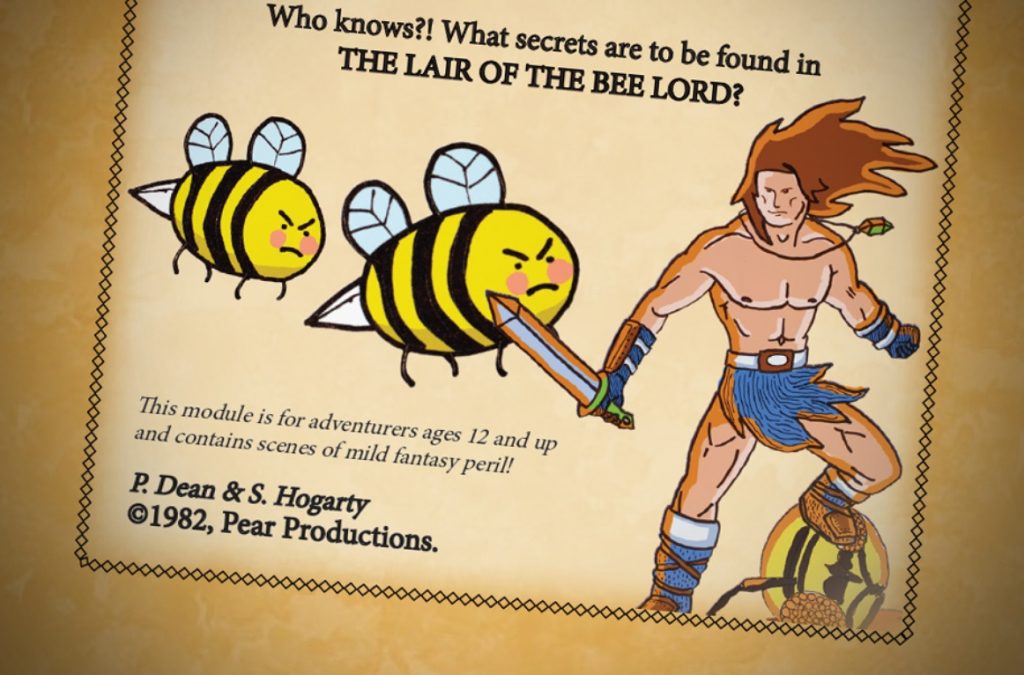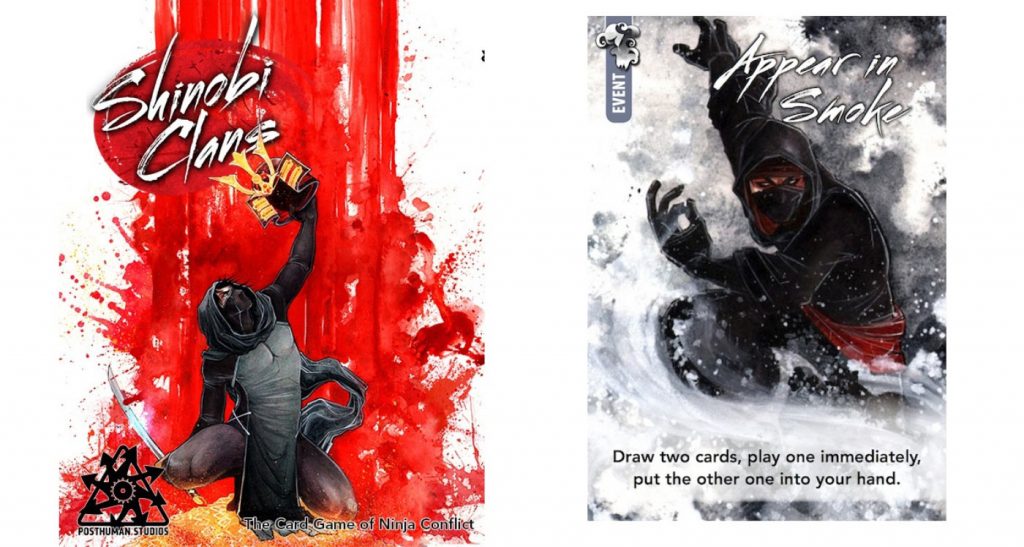Since our last foray into Actual Journalism was so well received (It was? — Mark.), we’ve decided to give it another go. This time, we take a look at Game Salute, a company headquartered deep in the hinterlands of New Hampshire, a state that somewhat resembles in shape a standard reference pear.
Game Salute styles itself as a new kind of publisher, one that does much more than handle marketing and fulfillment (fulfillment meaning “getting the game out to customers”, from receiving, to warehousing, secure storage, picking, packing, shipping, tracking, sales to stores globally and customer service).
Among the flexible services they offer are solutions for other publishers, and, intriguingly, managing Kickstarter campaigns, boasting such success stories as Alien Frontiers, as well as unique titles ranging from Chicken Caesar to Pixel Lincoln.
It was started as a response to the many pain points its CEO Dan Yarrington saw in the board game industry. To find out how the cure compares with the disease, we sent Actual Journalist Mark Wallace off to have a good long chat with Yarrington, and he came back (from a phone call, not from New Hampshire) with this exciting and informative Q&A!
Mark: How are you?
Dan: I’m great!
Mark: Thanks for taking the time to talk.
Dan: My pleasure.
Mark: Let’s go crazy and dispense with the names preceding each block of text, shall we? I’ll just set my questions and comments in italics, and everything else will be you. Lightly edited, of course. And with maybe some bold subheds from time to time. What do you say?
Dan: I love it.
Quinns: That exchange didn’t really happen, did it?
Mark: No.
WHAT GAME SALUTE IS
Game Salute’s Mission Statement reads, “Game Salute provides tools and services to make the tabletop games industry better.” But that could mean lots of things. Which of those things, I asked Yarrington, does it mean in Game Salute’s case? It means lots of things, as it turns out.
GameSalute is an ecosystem, a suite of services that allows publishers to focus on making games, as opposed to all the logistics. We publish titles through our Powered by GameSalute program, which is sales, logistics, fulfillment, receiving and storing inventory, and selling and shipping games, turnkey online storefronts, and publisher support of all types.
Our Feature Fulfillment program is the cornerstone of our publisher support. If you’re an independent small publisher, we handle all that logistical stuff.
Springboard is our crowdfunding support program, where a developer can test out ideas and see if they’re commercially viable in the marketplace. And for the developer or designer who just wants a game published, we have that option as well.
KICKSTARTER: EVEN IF YOU SUCCEED, YOU FAIL
I asked Yarrington what makes Game Salute stand out in an industry that has traditionally not been kind to anyone but the biggest of players, even in a period in which Kickstarter and other avenues of distribution have brought many more designers, publishers, and players into the fold.
Every gamer thinks he’s a designer, and every designer thinks they’re a publisher. Crowdfunding has sort of democratized things — but to the detriment of the participants.
My guesstimate is, 90% of successful Kickstarter campaigns actually fail, if you set the success rate as raising enough money to pay all the expenses. Most people end up cash-flow negative. Why? Because they’ve still got all this logistical stuff to deal with, everything from customer service to warehousing, setting up and managing an online store, managing their convention presence.
The fulfillment system that’s been in place is nowhere near ready to ship 1,000 individual packages [to Kickstarter backers], rather than pallets and cases. There might be 74 combinations of items in those packages. Traditional fulfillment can’t handle it, or is more expensive.
Through our Feature Fulfillment program, we handle all those logistics. And through Springboard, our crowdfunding program, we’re investing money, we pay for the art, the packaging, all the things to make it a successful product.
Publisher support [i.e., sales, fulfillment and related services] is the biggest volume we do, but Powered by Game Salute [i.e., publishing] is just starting to grow. Some of our Powered by Game Salute games are Island Fortress, which was one of the first games we worked on. Keyflower was released March 15, that’s doing very well. We also have Impact City Roller Derby, Cartoona, and Blackwater Gulch, which was released earlier in the year. And we have Pixel Lincoln coming up, and Nothing Personal, by Tom Vasel (the highly respected board game critic behind The Dice Tower).
MOST GAMES DON’T SUCK
We put $10,000 into a project to run the Springboard campaign, to see what demand is on Kickstarter. We reimburse ourselves out of the Kickstarter, and then we have whatever’s left for production and marketing. Part of that yield is for the developer.
Springboard gets 10-12 submissions a week now. In a good month, we might accept three or four. There are tons of questions we ask on the submission form: What’s the expected price point? How many times has it been playtested? How many unique builds have you had? We’re looking at the history of the game, its current state, its theme, price point, presentation. What it comes down to is us looking at the marketplace as a whole, and at the attributes of the games that are submitted, and saying, Is this going to be a good title?
Most games don’t suck. Most games are just okay. But there’s nothing innovative, nothing that would make me want to buy this over something else. So how do you differentiate? You can have more zombie games, that’s fine, but you have to have a hook, something that’s different, something that’s going to sell and be different in the specialty games marketplace.
That marketplace is unforgiving not just in terms of competition, but in the mechanics of marketing and distribution as well. Yarrington rightly laments the “black box between the publisher and sales data,” and the fact that the publisher bears the shipping costs all along the supply chain, from manufacturer to distributor, to fulfillment house, to retailer.
In the traditional distribution system, you only know what your gross sales are. You might know you sold 1,000 units to six big clients, but you don’t know where they are, you don’t know how many were sold online. Our system will let you see every month’s report to the publisher, the breakdown of how many are sold online, how many at conventions, how many direct to stores, how many through distribution partners. You get a much better picture of actual sales.
DIRECT CONNECTION ECONOMY
Yarrington had mentioned the “yield” for designers of Springboard titles. So I asked him about it. Because that’s how Actual Journalists roll.
The yield to developers is fairly comparable to traditional publishing [3-5%], although we tend to be on the higher end of the scale. Traditionally, if you’re a publisher, you’d sell a $50 game for $20 through wholesale, then you pay the shipping. The publisher then pays the developer 5% of that $20. So you as the developer make $1 on 95% of your sales.
In the new direct connection economy, or whatever you want to call it, if we’re selling direct [to the consumer] for $50, then the designer is getting $2.50 [5% of $50] instead of $1. The percentage stays the same, but the ratio of copies sold through authorized online sales or direct to consumers goes up.
We have a year’s worth of data now. About 25-50% of sales, depending on the game, gets sold through [direct] channels. The rest of it is through traditional channels. That’s a huge difference in terms of cash flow for a designer.
But it’s only a small difference in terms of how much information your distributor provides you. While a handful of companies with hit titles on their lists can sometimes command data about sales of specific games to specific retail stores, the kind of distribution figures available to board game publishers is nowhere near what purveyors of digital goods have access to. And publishers shoulder much of the costs, as well.
As a developer, you’re always going to be cash-flow positive. [If you somehow manage to have zero expenses and eat no food during all the hours you spend designing and developing your games. — Mark] The publisher bears the risks of costs, and the margins aren’t huge in tabletop games. Most of the costs get used up in shipping. Conventions alone, a 10’x10’ booth might cost $20,000 for the year, including travel, hotels, booth space at each show. Once you eat away all those costs, payment processing, fulfillment, boxes for shipping — at the end of the day, you really do have a 5-15% profit margin, assuming you’re not inflating the price of your game.
THE RANT
As Yarrington’s comments illustrate, board gaming, by its very cardboard nature, is a resolutely brick-and-mortar industry. Shelf space in Target and Walmart is what spells success to most big publishers; for many indies, a hot Kickstarter and the goodwill of the FLGS is all they can do to reach customers, let alone keep them engaged.
Meanwhile, almost every other industry on the planet is finding new and more powerful ways to acquire, engage and develop customers with the help of the globe-gobbling data-mine that is the Internet. Board gaming, by contrast, remains trapped in the ghetto of BoardGameGeek.com and the local game store.
And those are ghettos, make no mistake. Or if not ghettos, then monasteries at best, seats of unparalleled knowledge locked behind walls designed not to welcome but to enhance the separation between initiate and layperson. From a marketing perspective — and it’s marketing we’re talking about, to be sure; most games don’t suck — board gaming looks like an industry that’s still nervous about typing its credit card number onto the Internet.
The thing is, it doesn’t have to be that way. While there’s no getting around the fact that board games are physical goods — and must be designed, manufactured, shipped, and distributed at great cost — there’s a leap the industry isn’t making, into the deep end of the Internet pool. It’s the proverbial 21st century, after all: The future has finally arrived, and publishing anything is a different game now. Whether it’s books, music, computer games, or board games, publishing is no longer a matter of simply creating brilliant content, packaging it up, and then handing off your cargo of precious tuckboxes to a faceless distributor who’s never going to tell you more than “Yes, we shipped 1,000 copies to retailers in the western United States” — sales data that’s less than useless in making decisions about print runs and marketing spend.
Publishing now is as much about community as it is about content, about fostering connections not just between companies and consumers, but among individual customers as well. (And no, just having forums on your site doesn’t count.) It’s also about data, about the kind of data Game Salute, to its credit, is starting to provide publishers, but also about a layer of data that’s available almost nowhere — about who’s buying what, about who’s playing what, about what might be driving those decisions, and about how to use that information to connect more people with more games they might more enjoy. Enjoy more. Whatever.
The point is, designers and publishers have a great deal to gain by understanding how to leverage the audience and information available through the Web, how to package and distribute their message as well as they package their product, how to dig in and use the tools of digitalism to seed and grow a distributed community of face-to-face fans. And yet, almost none of them are doing it.
Quinns: Now hang on, can we go back to the names before each block of text for a minute?
Mark: Um, okay.
Quinns: That’s quite a rant you’ve just let loose with. Are you sure you feel comfortable putting it out on all the Internets like that? I know quite a few local game store aficionados with whom you are not going to be at all popular after we run this. And how do you think Yarrington’s going to feel?
Mark: I suppose I’ll take my chances. The piece isn’t meant to be a take-down of Game Salute by any means. They’re helping people get published, which is great. They’re just not the new kind of publisher I think board gaming needs. So yes, I suppose the piece is informed by some of my own preoccupations, and in particular the notion that board gaming can be so much more than what it is today, that it need not languish as a “hobby” but can graduate to the same category of entertainment we reserve for everything from books to movies to video games. If I bump into a couple of cows, sacred or otherwise, along the way to that goal, so be it.
Quinns: Right, then! On with our show.
49 DAYS
As one of the great face-to-face pastimes, board gaming is faced with a terrific opportunity. But very few publishers seem interested in taking advantage of it. I’d love to be able to tell you that Game Salute was one of those, but it isn’t true, at least not so far. Instead, it’s a company that comes from brick-and-mortar and to brick-and-mortar constantly returns. While Quinns was still trying to guess how many days past my deadline I’d be with this story, Yarrington sent me a follow-up email to let me know GS had expanded its warehouse once more since we’d spoken (for a total of five times this year).
That’s great news for Game Salute: it means there’s more product flowing through the system, and when you’re taking a slice of so many pies, more product flowing means more profits as well. The company can diversify its risk, distribute its costs, continue to sound out its market and raise funds through Kickstarter, and even lock in sticker prices through its authorized reseller program (see below).
All that adds up to is vertically integrated business as usual. It’s not Game Salute’s job to move boardgaming into the 21st century, of course. But it would be pretty cool if it was.
*After all, most game publishers don’t suck. Most publishers are just okay. *
YOU DON’T NEED ANYTHING WE SELL
Not all gamers put Game Salute in the “okay” column, however. To some, the Game Salute logo represents not a seal of quality, but a warning sign — in part because of the quality of their games and customer service, and in part because of what Yarrington calls “true pricing”: a retail price that can’t be discounted because Game Salute’s games are available only through authorized retailers who agree to sell at MSRP (Manufacturer’s Suggested Retail Price), despite the fact that every other game that costs $80 on the shelves of your local will cost you only $50 on Amazon. Still, many locals are big fans of the practice, because it saves them from the discounting that squeezes their already tight margins.
The MSRP [for most games] isn’t actually the market price of the game. Publishers actually price their games with a discount in mind. They’re squeezing the margins of the retailers here. They say, you should sell it for less, but I’m going to put it for $80 because I have to.
If we’re selling direct to consumer, it cuts jumps out of the shipping, it cuts the cost, it creates a better value for the publisher, for the designer, and it also creates what we call true pricing. This is a luxury industry, you don’t need anything we sell. If you don’t think it’s worth $50, don’t pay $50. I’d rather price at $50 [and sell at $50] than price at $80 and let it get marked down to $50. That’s a huge incentive for local stores as well.
Any authorized online store can sell our product. That includes Amazon and our own online store. Local stores can sell our product [online], but they have to sign up in a certain way and qualify. They can either buy the product through a local distributor, or direct from us.
Big companies do this all the time, have exclusive sales agreements. Smaller companies like ours don’t tend to do that kind of thing. We just want to make sure our brand is presented the right way, and that customers get the support they want, and make sure stores aren’t selling outside their territory.
A PSEUDO-SATIRISTIC CAMPAIGN
One of Game Salute’s successful Kickstarter campaigns was The Emperor’s New Clothes, a Kickstarter project that sought $5,000 and raised $6,330 for a game “inspired by an ingenious scam.” Many observers of the campaign, however, thought the “ingenious scam” was being perpetrated on them: the Kickstarter project showed a game with completely blank components, even after “extensive playtesting.” So, was this an art project, mislabeled prototype kit, social commentary, or ingenious scam? Or perhaps all of the above? Regardless, backers will get exactly what they paid for. Whatever that might be.
The Emperor’s New Clothes was a concept that we had, that we’d really love to do a prototype kit. It was on the back burner for a while, and then Jonathan Liu contacted us with the idea for a pseudo-satiristic campaign. Originally, he wanted to run it so you’re not sure if you’d actually get anything. But we said, it’s much better for the joke if you actually give them something that is blank, that has nothing on it. So we melded those two ideas, and were effectively just selling prototype kits.
We’re ordering it from the manufacturer now. After the Kickstarter, we’ll probably sell it under a different name, probably sell it as a GameBits prototype box or something like that.
It elicited the exact reaction you’d expect. Some people were vehemently opposed, other people thought it was hilarious. A ton of people [280, that is] said, Oh that is awesome, and pledged the $45 just for a memento. The value was in the entertainment. It was definitely a little avant garde. More of an art film than a blockbuster.
I think people recognized this is a social commentary on Kickstarter as well. A lot of Kickstarter projects are putting a bunch of keywords together with a bunch of art, and not thinking about what’s behind the game. People are still high on Kickstarter, but are just starting to receive their stuff, and you know what? It’s not as exciting now as it was when they pledged. And these are some big projects.
Part of what Jonathan wanted to do was make people think about these questions for every campaign. What are these people actually going to give me?
It was definitely experimental, but there was no misdirection. It was almost like an art project more than a game.
DAN’S CRAZY IDEA FILE
Despite kindly nattering on at my behest for the better part of an hour, Yarrington took a last minute or two to look to the future of Game Salute, and the industry’s ability to pull in new fans via the Friendly Local Game Stores that Game Salute supports.
We just launched Springboard Local Support. You pledge through the Kickstarter campaign, and it counts as if you bought it through a local store, so you’re supporting your local store [which gets a credit on their next order from Game Salute], and doing the Kickstarter. We need those local venues to support new people getting into the hobby.
We want to grow rapidly and take on lots more projects. There’s a whole bunch of areas, but most get filed in Dan’s Crazy Idea File. For instance, we did Preview Nights for a while, like film premieres, sending advance copies of games to all the stores. We’re always thinking about what’s a good concept to do, and creating things in terms of implementation that publishers are not willing to do.
[Mark Wallace is a journalist, author, game designer and the curator of Imaginary Atlas, a weblog mapping fictional places. His book on the strangest fictional place of all time — virtual community Second Life — can be found here.]

